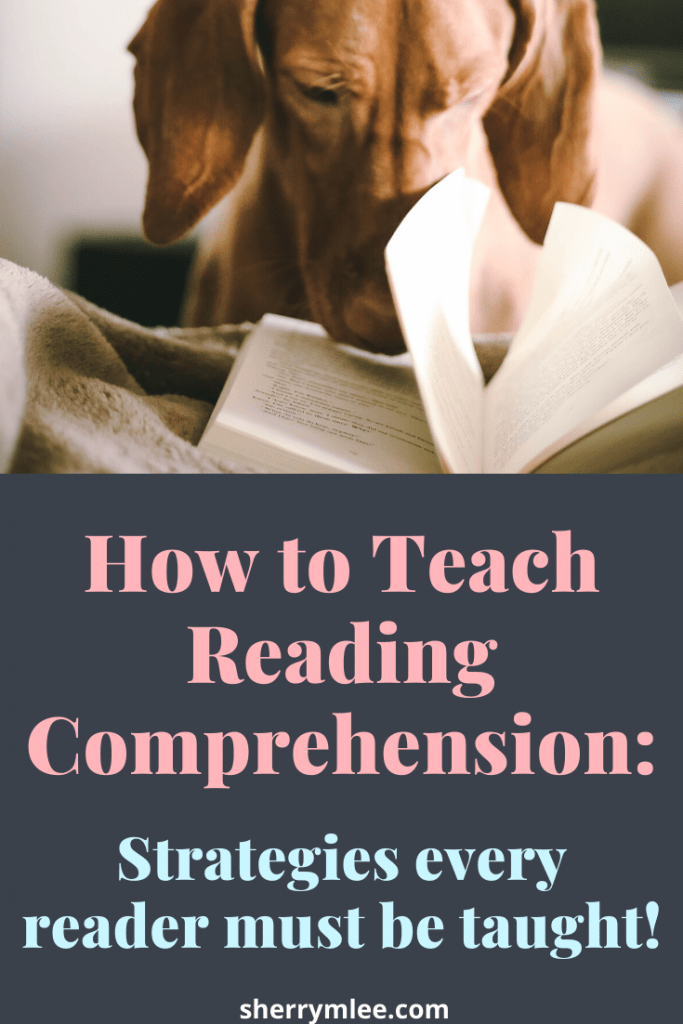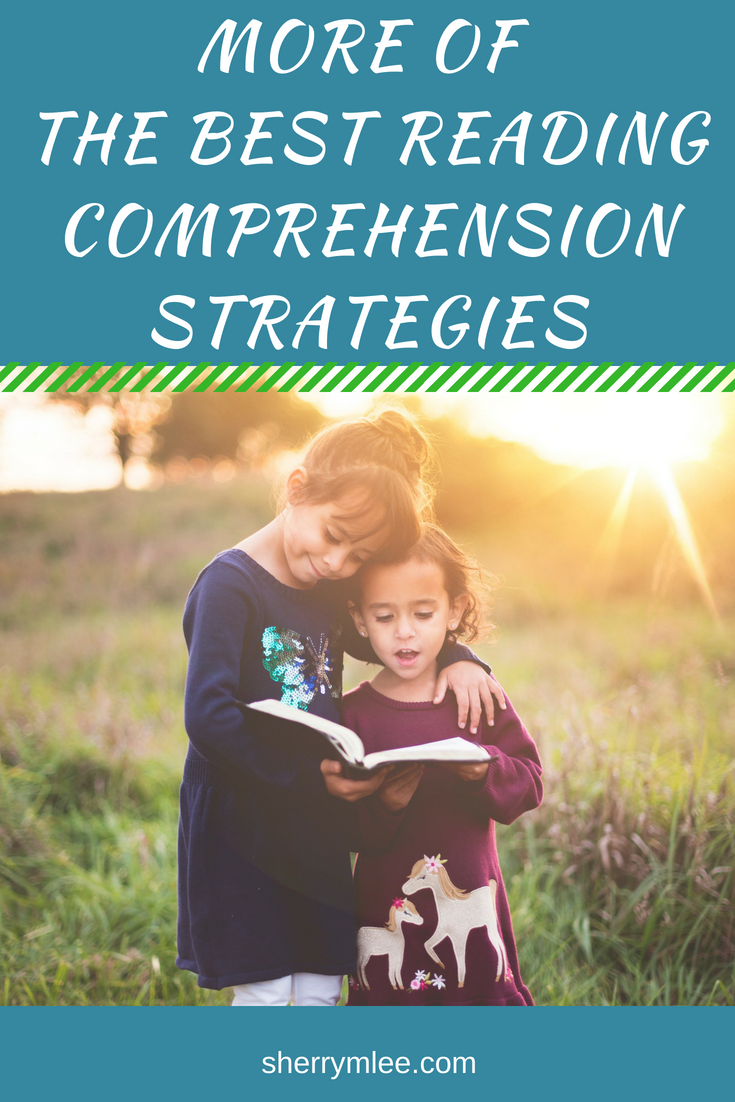What is reading comprehension? Reading comprehension refers to one’s ability to recall and understand the information that was read. It also refers to an individual’s ability to compare what was read with information the reader already knows. Reading comprehension is important because it really is the difference between someone simply reading words and someone reading as an “active participant” in his/her reading. The reader becomes much more engaged as reading becomes more fun and more informative.
Teaching our children reading comprehension strategies is necessary. We can’t assume they will just get it. Here are a few more reading comprehension strategies we can teach in addition to those mentioned in my post from last week!
*This post contains affiliate links, meaning I make a small commission on any purchases made at no extra cost to you. Thank you for your support!

Strategy 4: What to Do When One Drifts Off While Reading
I think we’ve all been there at some point when reading where we’ve asked ourselves the question, “What the heck did I just read about?” Sometimes we simply become dazed when reading. This is normal. It happens to the best of us.
So what can we do about it? First of all, let our kids know this happens to everyone at times. Next, encourage them to think about what they last remember reading. Some will need to go back to that part in the story and start again from there. As people get better at this, we can then focus more on skim reading to catch up on what was happening before our reading comprehension became fuzzy.

Strategy 5: Using Knowledge of Common Punctuation
Punctuation helps with knowing an author’s intent of how a story is to be told. The use of a comma, for example, can indicate that someone is about to speak. It can also indicate that the author wants to break up a sentence or provide more information. It is not uncommon for definitions of difficult words to be given between commas or after one if the reader knows to look for this.
Other punctuation, such as a question mark or exclamation point will change how we read a particular sentence.
Regardless of the punctuation, the types that end at the bottom right of words are best to pause at when reading. This includes periods, commas, exclamation points and so on. Knowing and implementing this can help a lot with comprehension.
Quotation marks are another method of punctuation that should not be left out. They indicate that someone is speaking. This may seem obvious to those of us who frequently read for enjoyment, but it isn’t obvious at all for many individuals who are not yet there. Knowing that a new speaker will be introduced in a new line or paragraph is also important knowledge for reading comprehension.
I suggest that punctuation be the focus when reading with your child for an evening or two. Stopping to discuss why an author used a comma or certain punctuation mark can really help kids digest and retain the information, thus making it an automatic part of their reading comprehension skills.

Strategy 6: Use Typography Tips
Why are words italicized or bolded within a story? Italicized words can be used to show that a word is to be emphasized in reading it. They can also indicate thoughts or a dream. Some authors prefer the use of bolded words to this, especially when wanting a word or phrase emphasized.
This switches when it comes to textbook reading. Bolded words within a textbook are bolded at the beginning of a chapter to indicate the word is in the glossary or is being defined somewhere on the page. These words are generally only bolded the first time they are seen within a chapter. Knowing this information can really help students with comprehension of textbook reading, as they become aware that more information is provided within the textbook should they need it.
When these pieces of information are specifically brought to the attention of our children, it can really help them with reading comprehension. Simply pointing out some of these examples and having discussions around why the author has used italicized or bolded words will help our children remember them and better understand what they are reading.

Strategy 7: Practice Reading with Emphasis
Have you ever told a really exciting and engaging story using a monotone voice? Probably not. A good story should be told with emphasis if it is to be fully comprehended. This may require practicing reading stories aloud even if this hasn’t been done for quite some time. This will also help with fluency.
Reading with emphasis may require practice. If so, it may work to read a sentence once, then go back and reread it with emphasis. Once understood, knowledge around the punctuation and typography used within a sentence will give clues as to how the sentence is to be read.
In my opinion, reading aloud is often discouraged way too early. Kids become encouraged to read “in their heads” to allow for silence. Reading aloud provides the practice for fluency and learning to read with emphasis that is so important. If keeping the reading environment quiet is necessary, many find reading with these auditory feedback phones helpful.
If there is a younger child in the home, he/she can provide an ideal practice opportunity for the monotone reader. I know I used to switch to a monotone voice when wanting my children to fall asleep. However, when I wanted them to be fully engaged and enthusiastic about the reading? Well, then I read like a crazy lady on some substance that makes my voice change each time a new character talks!
Reading with emphasis is not only fun, but it definitely helps with one’s reading comprehension as well.

Rule Out a Reading Difficulty
Do you have readers in your life that don’t appear to be grasping reading as you believe they should be? Is your reader continuing to have difficulty with reading comprehension even though you have gone over strategies together?
If you suspect your child may have any type of reading difficulty, you will benefit from checking out Reading Made Easy. This eBook is the ultimate guide to get your struggling reader on a successful reading path once and for all! It goes over various roots of reading difficulties and how each present themselves. Simple and targeted solutions are provided for working through each root.

In Summary
The reading comprehension strategies covered here and in last week’s post are just a few of the strategies that an individual can be taught. I hope they are helpful to you and the readers in your life!
What are some of your favorite reading comprehension strategies? Please let me know in the comments below.


7 Comments
Where was this when I was a child. This happened a lot in literature class lol. Great article!
Thank you so much for reading it! I’m glad you found it helpful. 🙂
As an English teacher/tutor, I found this very helpful, particularly with younger students, those with learning disabilities, ESL students, or students who are weaker readers in general. You’re absolutely right that if we read a lot, there’s so much we take for granted. There’s no use covering advanced concepts like themes and symbolism before children have the basics mastered.
I’m so glad you found this helpful! Thank you for reading it. 🙂
Very interesting and useful tips. Good read.
Thank you for the positive feedback. It is very much appreciated! I’m glad you found the article useful. 🙂